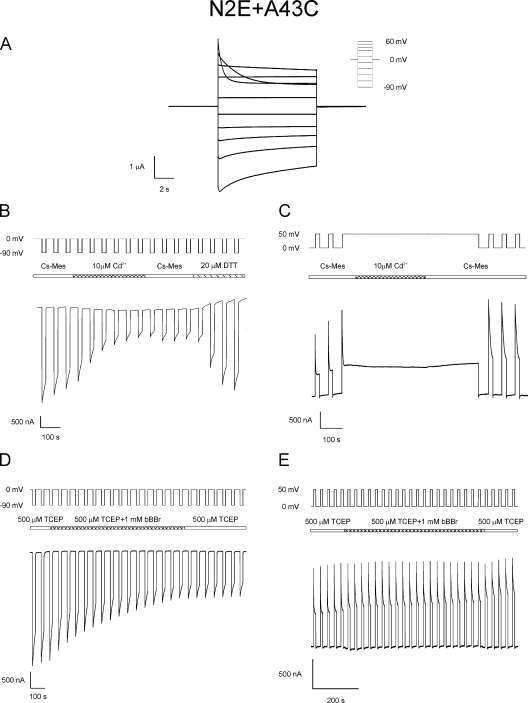XB-IMG-124055
Xenbase Image ID: 124055

|
Figure 8. Unapposed N2E+A43C hemichannels are locked by cadmium and accessible to bBBr modification when the channel is closed by loop gating, but not Vj gating. (A) Macroscopic current traces obtained from N2E+A43C unapposed hemichannels after polarizations to voltages shown in the inset of 0 mV. Current relaxations at hyperpolarizing and depolarizing potentials result from the closure of loop and Vj gates, respectively. (B) Macroscopic currents were recorded from oocytes expressing the double mutation, N2E+A43C. The N2E mutation reverses the polarity of Vj gating from closure at hyperpolarizing potentials to closure at depolarizing potentials but does not change the polarity of loop gating. The application of 10 µM CdCl2 during a series of voltage steps between 0 and −90 mV causes a large decrease in membrane currents that can only be reversed by treatment with 20 µM DTT. Polarizations to −90 mV strongly favor the closure of loop gates, whereas residency in the open state is favored at a holding potential of 0 mV. (C) Macroscopic currents recorded from N2E+A43C oocyte using a similar protocol to that used in Fig. 5 B. 10 µM CdCl2 was applied to the channel after a long-duration depolarizing step to 50 mV that strongly favors closure of only the Vj gates. After wash with Cs-MES bath solution, the effect of cadmium on Vj gate closed channels was assessed by the application of a series of polarizing steps between 0 and 50 mV. This polarization elicits gating transitions between the open and Vj-gating closed states. Currents were similar to those obtained before cadmium application, demonstrating that A43C residues do not coordinate cadmium when the channel is closed by Vj gating. (D) Macroscopic current traces elicited by repeated polarizations between 0 and −90 mV, a voltage paradigm that elicits transitions between open and loop gate closed channels. At the position indicated, channels were exposed to 1 mM bBBr in the presence of 500 µM TCEP and subsequently washed with 500 µM TCEP. The observed reduction in current is consistent with a reaction between the A43C residue and bBBr. (E) Macroscopic current traces elicited by repeated polarizations between 0 and 50 mV, a voltage paradigm that results in the opening and closing of Vj gates. At the position indicated, channels were exposed to 1 mM bBBr in the presence of 500 µM TCEP and subsequently washed with 500 µM TCEP. The absence of any reduction in current is interpreted to indicate the inaccessibility of A43C residues to bBBr modification when the N2E+A43C channel resides in the open state and the Vj-gated closed state. Image published in: Tang Q et al. (2009) © 2009 Tang et al. Creative Commons Attribution-NonCommercial-ShareAlike license Larger Image Printer Friendly View |
